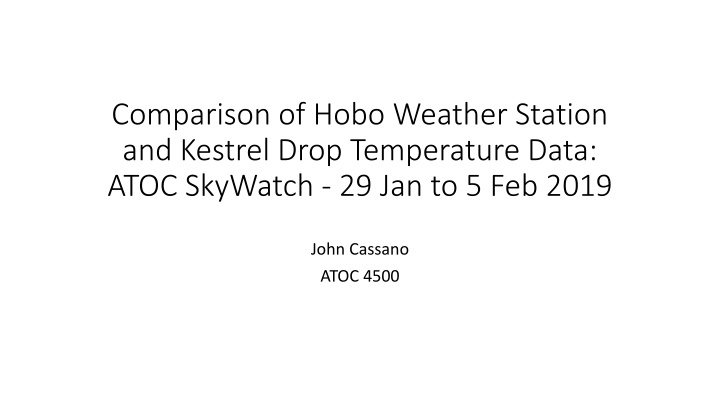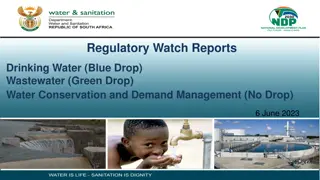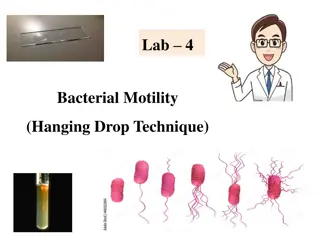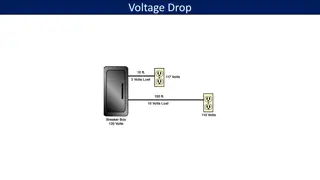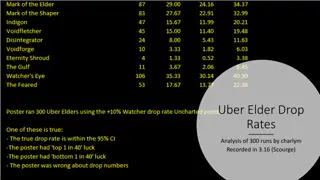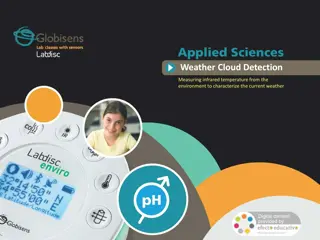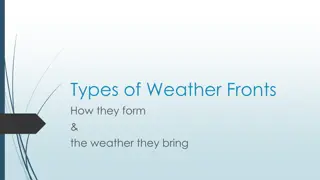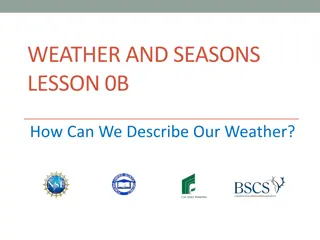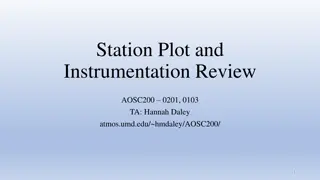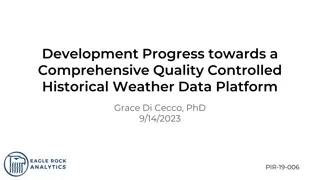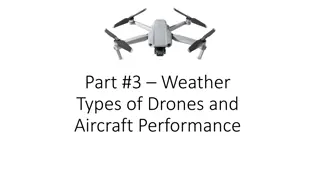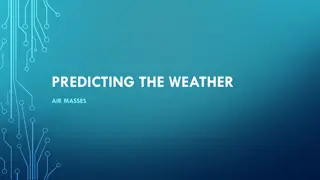Comparison of Hobo Weather Station & Kestrel Drop Temperature Data at ATOC SkyWatch
This study compares temperature data from Hobo weather stations and Kestrel Drop sensors during a week-long deployment at ATOC SkyWatch. It analyzes the similarity/dissimilarity in reported temperatures, presence of solar radiation errors, bias in sensors, and suggests corrections for future analyses. The comparison reveals differences in scatter and biases between the sensors, highlighting the importance of proper sensor positioning and cross-sensor offsets. Factors affecting temperature observations, such as wind speed and ventilation, are also discussed.
Download Presentation

Please find below an Image/Link to download the presentation.
The content on the website is provided AS IS for your information and personal use only. It may not be sold, licensed, or shared on other websites without obtaining consent from the author.If you encounter any issues during the download, it is possible that the publisher has removed the file from their server.
You are allowed to download the files provided on this website for personal or commercial use, subject to the condition that they are used lawfully. All files are the property of their respective owners.
The content on the website is provided AS IS for your information and personal use only. It may not be sold, licensed, or shared on other websites without obtaining consent from the author.
E N D
Presentation Transcript
Comparison of Hobo Weather Station and Kestrel Drop Temperature Data: ATOC SkyWatch - 29 Jan to 5 Feb 2019 John Cassano ATOC 4500
Objectives Compare temperature observed by Hobo weather stations and Kestrel Drop sensors from a 1 week deployment at ATOC SkyWatch Under what conditions do these sensors report similar / dissimilar temperatures Is a solar radiation error present in the observed temperature? If so, how large is this error? What conditions minimize / maximize this error? What corrections and uncertainty estimates should be applied to these sensors for future analyses? What is the mean difference between each sensor and a reference sensor? How much scatter is present in the observations relative to a reference sensor?
Comparison of Hobo and Kestrel Sensors For Hobo sensors: Most of scatter is between +/- 1 deg C Afternoon positive temperature bias for T-RH sensor on Hobo01 (and to a lesser degree for Hobo02) For Kestrel Drop sensors: Most of scatter is between +/- 2 deg C But, Kestrel sensors have large positive bias in afternoon Afternoon bias can be 10+ deg C D09 has inconsistent bias signal and appears to be unreliable
Comparison of Hobo and Kestrel Sensors vs D01 Comparing sensors to D01 increases spread for Hobo obs to +/- 2 deg C and decreases spread for Kestrel sensors to +/- 1 deg C Afternoon warm bias is still present for Drop sensors and is not the same between sensors suggesting small-scale differences in position are important Afternoon cold bias for Hobo sensors consistent with Drop sensors having positive radiation error relative to shielded Hobo sensors Recommend calculating offsets between sensors based on Kestrel Drop instead of Hobo sensors
Temperature Differences vs Wind Speed Largest scatter between observations for light wind speeds Scatter between observations greatly reduced for wind speed > 5 m/s When well ventilated all sensors report similar temperatures
Temperature Differences vs Time of Day (UTC) Reduced scatter between observations during overnight period (00 to 14 UTC) Large scatter during daytime (14 to 24 UTC) This suggests that the Hobo and Kestrel sensors are well suited for nighttime studies but may not be reliable for daytime analysis These results suggest comparison between different sensors at night will produce scientifically useful results Comparison between different sensors during the day will not be reliable
Temperature Differences vs Solar Radiation Note: These plots are for differences from Hobo01 T Increased scatter occurs for solar radiation > 100 W/m2 for Kestrel Drops and > 150 W/m2 for Hobo sensors Little evidence for solar error on other Hobo sensors aside from Hobo01 T-RH Drop sensors have warm bias of up to 10+ deg C for solar radiation > 100 W m-2 Time series plots shown previously indicated reduced positive bias on afternoon of 4 Feb This day had strong winds which provided ventilation that reduced solar radiation errors in unshielded Kestrel sensors
Average Difference Average Difference For all data: Average difference for Kestrel Drops is mostly less than 0.4 deg C Average difference for Hobo sensors is within +/- 0.2 deg C These results are consistent with the reported accuracy of the sensors (0.5 deg C for Kestrel and 0.2 deg C for Hobo) For data filtered by solar radiation: Differences for all sensors is reduced to < 0.2 deg C (except Hobo02 T-RH) There is little change for no radiation or radiation < 100 W m-2 Recommend calculating sensor corrections for solar radiation < 100 W m-2 and relative to D01 sensor
Standard Deviation Standard Deviation For all data: Standard deviation for Drop sensors is between 1.5 and 2.5 deg C for differences from Hobo Drop standard deviation decreases to between 0.5 and 1.5 deg C for differences from D01 For data filtered by solar radiation: Standard deviations mostly less than 0.5 deg C for all sensors These results suggest that nighttime data will have an uncertainty of approximately 0.5 deg C This is the minimum meaningful temperature difference we can identify between any pair of sensors
Conclusions Compare temperature observed by Hobo weather stations and Kestrel Drop sensors from a 1 week deployment at ATOC SkyWatch Under what conditions do these sensors report similar / dissimilar temperatures Smallest differences between sensors occur: At night (00 to 14 UTC) With solar radiation < 100 W m-2 With winds greater than 5 m s-1 Kestrel D09 sensor is unreliable Is a solar radiation error present in the observed temperature? Yes for the Kestrel Drop sensors No for the Hobo sensors except Hobo01 T-RH If so, how large is this error? Kestrel Drop radiation error can be 10+ deg C What conditions minimize / maximize this error? Radiation error is negligible for solar radiation < 100 W m-2 Strong winds (4 Feb) reduced but did not remove the radiation error
Conclusions What corrections and uncertainty estimates should be applied to these sensors for future analyses? What is the mean difference between each sensor and a reference sensor? Mean differences are mostly less than 0.2 deg C once observations are filtered for solar radiation < 100 W m-2 How much scatter is present in the observations relative to a reference sensor? The standard deviation of sensor differences is mainly less than 0.5 deg C once observations are filtered for solar radiation < 100 W m-2
Conclusions: Recommended Corrections Relative to D01 Sensor Correction (deg C) Hobo01 T -0.2 Hobo01 T-RH -0.2 Hobo02 T -0.2 Hobo02 T-RH -0.5 Sensor Correction (deg C) Sensor Correction (deg C) Sensor Correction (deg C) D01 D06 0.3 D11 0.0 D02 0.0 D07 0.0 D12 0.0 D03 0.2 D08 n/a D13 0.2 D04 0.1 D09 -4.8 D14 0.1 D05 0.1 D10 0.2 D15 0.2
